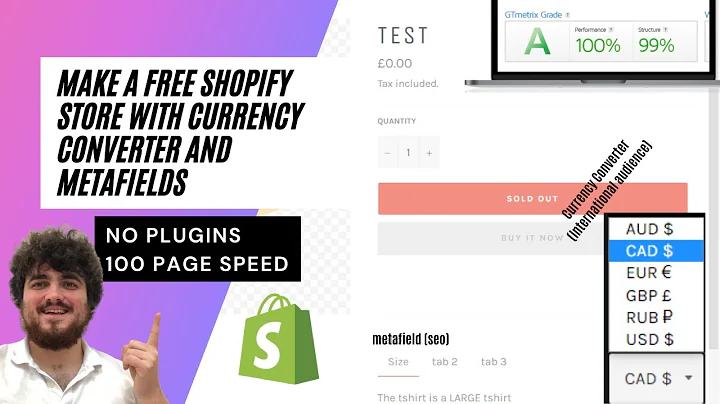Discover Hydrogen: A Streamlined Framework for Custom E-commerce Sites
Table of Contents
- Introduction
- What is Hydrogen?
- The Purpose of Hydrogen
- Developer Experience
- Components and Pages
- Building a Server-rendered Frontend
- Pre-built Components
- Customization Options
- Pages and Routes
- The Future of Hydrogen
- Conclusion
Introduction
In this article, we will explore the latest JavaScript framework called Hydrogen. We will delve into its features, advantages, and potential use cases. From its server-side rendering capabilities to its pre-defined components, Hydrogen aims to offer a streamlined approach to building custom e-commerce sites using Shopify. Join us as we uncover what makes this framework unique and evaluate its potential benefits for developers.
What is Hydrogen?
Hydrogen is a React-based framework that focuses on server-side rendering for building custom e-commerce sites on the Shopify platform. By leveraging the GraphQL API provided by Shopify, Hydrogen simplifies the process of creating fully customizable storefronts. It serves as a starting point for developers who want to break away from cookie-cutter templates and design unique e-commerce websites.
The Purpose of Hydrogen
While platforms like Shopify, BigCommerce, and Squarespace are popular for building e-commerce sites, they often result in websites that feel generic and lack customization. Hydrogen bridges this gap by providing a framework that connects to the Shopify backend with minimal effort. Developers can create fully customizable storefronts using pre-defined components and hooks, making it easier to differentiate their websites from the standard templates provided by e-commerce platforms.
Developer Experience
The developer experience with Hydrogen is designed to be user-friendly and efficient. The project setup is straightforward, with a command to create a new Hydrogen app. The provided starter template comes with essential configurations and tools, including a shopify config file, a beat build tool, and integration with Tailwind CSS. However, some may find the default use of Tailwind CSS polarizing, and it might be preferable to have plain CSS as the default option. Nonetheless, developers have the flexibility to override or customize these configurations according to their preferences.
Components and Pages
Hydrogen comes with a wide range of pre-built components, setting it apart from traditional frameworks that primarily focus on the backend. These components cater specifically to e-commerce functionalities, such as shopping carts. While the abundance of pre-built components may feel overwhelming, it provides a starting point for customization and allows developers to build upon them as needed.
The organization of pages in Hydrogen resembles the structure used in Next.js, where the directory structure determines the routing. This simplified approach eliminates the need for explicit configuration with tools like React Router. Additionally, Hydrogen introduces a custom hook, "use shop query," which simplifies data fetching from the Shopify GraphQL API. By rendering the data on the server, Hydrogen ensures search engine bots and social media link bots can understand the content, making it SEO-friendly.
Building a Server-rendered Frontend
A significant advantage of Hydrogen is its server-side rendering capabilities. It leverages server components in React, which are capable of fetching data and rendering plain HTML on the server. This feature ensures a search engine-friendly web app, an essential requirement for e-commerce websites. Hydrogen's server.js file reveals that the framework is built on top of Express.js, with added hydrogen middleware. Furthermore, Hydrogen provides a Docker file for easy deployment to a production server.
Pre-built Components
The extensive collection of pre-built components in Hydrogen contributes to its unique hybrid nature—a combination of a template and a framework. These components offer functionality commonly required in e-commerce websites, such as shopping carts. While it may appear overwhelming initially, the range of pre-built components ultimately serves the purpose of providing a starting point for developers, which they can tailor to meet their specific requirements.
Customization Options
Hydrogen's primary goal is to enable developers to create fully customizable storefronts. By using pre-defined components and hooks, developers can easily customize the appearance and functionality of their websites. The flexibility and ease of customization ensure that developers can break away from the cookie-cutter template feel often associated with e-commerce platforms.
Pages and Routes
Following a similar approach to Next.js, Hydrogen utilizes a straightforward pages directory structure to determine routes or URLs in the application. This method simplifies the configuration required for routing and makes it easier for developers to manage their application's structure.
The Future of Hydrogen
Hydrogen's future holds promising potential as it aligns with the broader trend of using server components in React. Building on server components makes it simpler to create server-rendered React apps without relying on complex abstractions. This approach could pave the way for more specialized JavaScript frameworks like Hydrogen, which focus on solving domain-specific problems. It remains to be seen whether Hydrogen will thrive as a standalone framework or be integrated into existing frameworks like Next.js.
Conclusion
Hydrogen presents an exciting prospect for developers seeking to build custom e-commerce sites on Shopify. With its server-side rendering capabilities, pre-built components, and simplified developer experience, Hydrogen offers a streamlined solution for creating unique storefronts. However, it faces questions about differentiation from existing frameworks and the potential impact of Shopify's upcoming hosting service, Oxygen. Despite these uncertainties, Hydrogen's focus on customization and ease of use can undoubtedly appeal to developers looking to break away from cookie-cutter e-commerce templates.






















